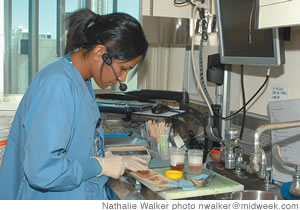
Searching Cells For Cancer
October 01, 2008
By Dr. Peter Bryant-Greenwood


Dr. Peter Bryant-Greenwood
Medical Director of Pathology Services at The Queen’s Medical Center Pathologist, Hawaii Pathologists’ Laboratory
Interviewed by Melissa Moniz
Where did you receive your schooling and training?
I grew up in Honolulu. I went to Iolani for high school and then I went away to Georgetown for my undergraduate degree in the School of Foreign Service. Then I came back to the University of Hawaii for medical school. For residency, I trained in the Laboratory of Pathology, National Cancer Institute at NIH, Bethesda Md. I was recruited back to Hawaii in 2003 by Dean Ed Cadman to lead a clinical proteomics program at John Burns School of Medicine. I have been a practicing pathologist for the last seven years.
{embed=“elements/box_ad”}
What is your area of specialty?
Sub-specialization in pathology is very common. In our department, we have nine pathologists and each one has his or her area of expertise. My particular areas are surgical pathology, cytopathology and molecular diagnostics. It sounds like a lot, but it’s basically looking at people’s tissues and cells to determine whether they have cancer. Molecular diagnostics is the application of very specialized genomic and proteomic technologies to cancer specimens to ascertain how aggressive a patient’s tumor is and whether it will respond to a specific chemotherapy.

|
You mentioned cancer. Is that primarily what you examine and diagnose?
In terms of surgical and cytopathology, looking for cancer represents about 90 percent of the enterprise.
Is there ever a question whether a tissue/cells specimen is cancerous or not? And in those cases, what is done?
In those cases, we can do one of two things, or both. One is we can always send it to a world expert, which occurs in about 0.5 percent of cases. The other thing we can do is to communicate with the surgeon, medical specialist or OB/GYN that the biopsy we have is indeterminate, and that we will need more tissue for an accurate diagnosis. This dilemma faces all pathologists. This is why two pathologists review all cancer diagnoses at the Queen’s Medical Center and Hawaii Pathologists’ Laboratory. It is also why we review all pathology specimens from patients from other hospitals who seek treatment at the Queen’s Cancer Center.
Are most of your interactions with physicians, and you don’t really see patients?
For the most part, we serve as consultants to other physicians, rarely seeing patients. For the most part, our direct patient contact occurs when we perform a biopsy called a FNA (Fine Needle Aspiration) - a small needle we put into a mass or nodule to take out some of the cells to see if they are cancerous or not. We also sometimes see patients in the ICU to help make sure the patients get the right kind and right amount of blood or blood products when they need a transfusion. Lastly, we also see patients at autopsy, when family members have questions about how their loved one passed.
Can you discuss further the different sub-specialties within pathology?
We divide the world of pathology into two different tracks. People who complete their training in pathology are entitled to do both, but what usually happens is they choose one over the other. So there’s anatomic pathology, which is looking at tissues and cells, and there’s clinical pathology that has to do with blood tests. There are several sub-specialties within anatomic pathology. These include dermatopathology, cytopathology, neuropathology, forensic and hematopathology, among others. The clinical pathology specialties include clinical chemistry, microbiology and blood banking.
{embed=“elements/google_ad336x280”}
I also heard of veterinary pathology, plant pathology and of course, forensic pathology. Can you discuss how those specialties are related to what you do?
Pathology is the study of disease. So, at a fundamental level, all these disciplines are related. While we (human pathologists) are required to be medical doctors, other fields of pathology require different training and type of expertise. Plant pathologists study disease that affect agriculture.
Veterinary pathologists do many things from diagnosing a tumor in your pet to determining what killed a valuable animal at the Honolulu Zoo, to making sure our beef cows do not have Mad Cow Disease. They also are very involved in helping humans by studying the effect of drugs and other treatments on animals before we try them on humans. Forensic pathology is a specialty of human pathology; so one has to be a medical doctor, complete pathology residency and sub-specialty training.
Forensic pathologists serve the public to determine how a person may have died in the advent of an unattended death. Most everyone thinks of murders, but determining the cause of suicides and accidental deaths is very important to our society - was the person driven to suicide by a medication interaction or drug intoxication? Did a drowning victim have his scuba tank fail or did he have a heart attack?
What do you see as the future of pathology?
The future of pathology is very exciting. There is enormous pressure on us to develop more-accurate, cost-effect tests to detect disease at an earlier stage. Detecting a disease earlier, whether it is cancer, heart disease, Alzheimer’s or pre-term labor means treatments are easier and more effective.
Fortunately, we have help - “translational” research scientists and engineers who work for government, universities and industry devise new tests all the time. It is our job to work with them to make sure a new test not only works, but is also cost-effect and has a material impact on clinical care. This is especially true in Hawaii, where our population is racially diverse, ethnically unique and isolated. What good is a test if it only applies to U.S. Mainland populations, or we do not have access to the right treatments?